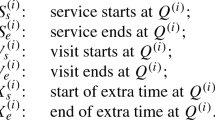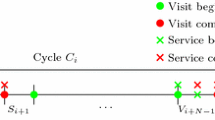Abstract
In this paper we evaluate the waiting time performance of cycle-time guided algorithms in semi-dynamic polling models. In these models knowledge of the system state is used by the server in the process of on-line determination of the visit pattern. Our main focus is on pseudo-cyclic algorithms which achievefairness by visiting every station exactly once in each cycle.
It is shown that in fully symmetric systems the performance ofevery pseudocyclic policy is bounded between the performance of the cycle maximization and the cycle minimization strategies. In particular, stochastic dominance is shown with regard to system workload, implying dominance of mean waiting times. In a fluid approximation model the performance ratio between the two bounding policies is derived and shown to be always between 1 and 3/4 under the gated service regime and between 1 and 1/2 under the exhaustive service regime. Under both regimes, the ratio approaches 3/4 when the number of stations grows to infinity. Simulation results suggest that a similar performance ratio holds for the general (non-symmetric) stochastic model.
Further, we study strategies which are guided by the cycle maximization (minimization) criteria, but which do not constrain themselves to pseudo-cyclic orders. It is shown that depending on the switch-over parameters these more dynamic policies may perform much worse than the pseudo-cyclic schemes.
Similar content being viewed by others
References
S. Browne and U. Yechiali, Dynamic priority rules for cyclic-type queues, Adv. Appl. Prob. 21 (1989) 432.
H. Takagi, Queueing analysis of polling models, in:Stochastic Analysis of Computer and Communication Systems, ed. H. Takagi (North-Holland, Amsterdam, 1990).
O.J. Boxma, H. Levy and J.A. Weststrate, Optimization of polling systems, in:Performance '90, eds. P.J.B. King, I. Mitrani and R.J. Pooley (North-Holland, Amsterdam, 1990) pp. 349–361. Also, Technical report BS-R8932, CWI (April 1991).
O.J. Boxma, H. Levy and J.A. Weststrate, Efficient visit frequencies for polling tables: minimization of waiting costs, Queueing Syst. 9 (1991) 133–162.
H. Levy, M. Sidi and O.J. Boxma, Dominance relations in polling systems, Queueing Syst. 6 (1990) 155–172.
I. Meilijson and U. Yechiali, On optimal right-of-way policies at a single-server station when insertion of idle times is permitted, Stoch. Proc. Appl. 6 (1977) 25.
M. Hofri and K.W. Ross, On the optimal control of two queues with server setup times and its analysis, SIAM J. Comp. 16 (1987) 399.
Z. Liu, P. Nain and D. Towsley, On optimal polling policies, Queueing Syst. 11 (1992) 59–83.
L. Kleinrock,Queueing Systems, Vol. 2 (Wiley, New York, 1976).
H. Takagi,Analysis of Polling Systems (MIT Press, 1986).
O.J. Boxma, private communication.
Author information
Authors and Affiliations
Rights and permissions
About this article
Cite this article
Fabian, O., Levy, H. Pseudo-cyclic policies for multi-queue single server systems. Ann Oper Res 48, 127–152 (1994). https://doi.org/10.1007/BF02023096
Issue Date:
DOI: https://doi.org/10.1007/BF02023096




